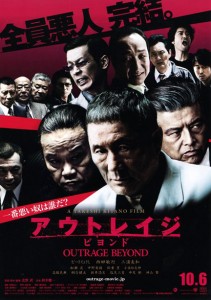Director: Takeshi Kitano
Writer: Takeshi Kitano
Cast: Beat Takeshi, Tomokazu Miura, Ryo Kase, Akira Nakao, Shigeru Koyama, Toshiyuki Nishida, Sansei Shiomi, Katsunori Takahashi, Fumiyo Kohinata, Yutaka Matsushige, Hideo Nakano, Kenta Kiritani, Hirofumi Arai, Tetsushi Tanaka
Running Time: 112 min.
By HKFanatic
After delivering a modern update on the popular Zatoichi character in 2003, writer/director/actor Takeshi Kitano spent the rest of that decade on a detour into the world of avant garde cinema. Films like Glory to the Filmmaker! and Achilles and Tortoise had ostensibly little in common with the violent cop and Yakuza features that helped make Kitano an international sensation. Thus, it was viewed as something of a return to form when Kitano explored the Japanese criminal underworld once again with 2010’s Outrage.
Outrage was a brutal, brutal film – it felt like at least one character was beaten or murdered every ten minutes, and it did for dental offices what Jaws did for the beach. While most fans of Asian cinema were quite pleased with Kitano’s delivery of bloody Yakuza thrills, there was a vocal contingent of critics who felt that the filmmaker had lost the poetic and meditative quality that defined earlier works such as Sonatine and Fireworks.
Watching the 2012 sequel Beyond Outrage, it’s easy to suspect that perhaps Kitano felt the same way. In The Godfather Part II fashion, the movie picks up exactly where the first movie left off; however, the brutality is noticeably scaled back and there is a renewed focus on the backroom dealings and protracted schemes that make up the plot. As the film opens, Kato (Tomokazu Miura) is the President of the Sanno Yakuza faction, but there are many in clan who are not happy with his leadership style – and suspect that the mysterious death of their previous leader wasn’t so mysterious after all. An underboss named Tomita (Akira Nakao) travels all the way to Okinawa to visit the Hanabishi faction in order to solicit their leaders for help in deposing Kato. While Tomita’s bid doesn’t exactly play out the way he intended, it does set the stage for a deadly conflict which both factions may not survive. How does Takeshi Kitano’s character Otomo, who seemingly died of stab wounds at the end of the first Outrage, play into this? Well, I wouldn’t dare spoil that.
With such a setup, one might expect Beyond Outrage to quickly escalate into a bloodbath par excellence. But this time around, Kitano is out to skewer a corrupt society rather than build a higher body count. In the world of Beyond Outrage, police collusion with the Yakuza is viewed as almost a given; and the Yakuza are portrayed as something like the shadiest business in town – you might lose your life rather than your job after a bad quarter, but in the end these gangsters are still just another business in the cutthroat capitalistic world they occupy.
This isn’t to imply that Beyond Outrage is a bloodless affair: a batting cage sets the scene for the film’s most gruesome killing. But Kitano seems to consciously steer clear of the Grand Guignol of the original. This leads to a noticeably slower pace to Beyond Outrage, though the real disappointment is that the characterization of some of the characters often feels inconsistent with the first film. In particular, the snake-like Ishihara (Ryo Kase) betrays the calculating menace that made him such a threat in Outrage; while even President Kato has lost much of the cool and calm he displayed sitting on the throne in the final scene of Outrage. Heavy is the head that wears the crown, indeed.
Some have speculated that Takeshi Kitano is more or less ‘over’ the Yakuza genre – and the hyper-violence of Outrage was just his way of giving the movie-going public what they wanted. In truth, Kitano admitted in an interview that he hoped the sequel was a massive hit so producers would finance a film he “really wants to do.” Still, even if the Outrage series is just Kitano’s way of gaining the cache to greenlight his next passion project, we’ve gained two solidly entertaining movies out of the deal. While Beyond Outrage may not reach the heights of its predecessor, the performances, cinematography, and editing are all on par with the original. Here’s hoping Kitano returns for one final, bloody coda to the series.
HKFanatic’s Rating: 7/10




